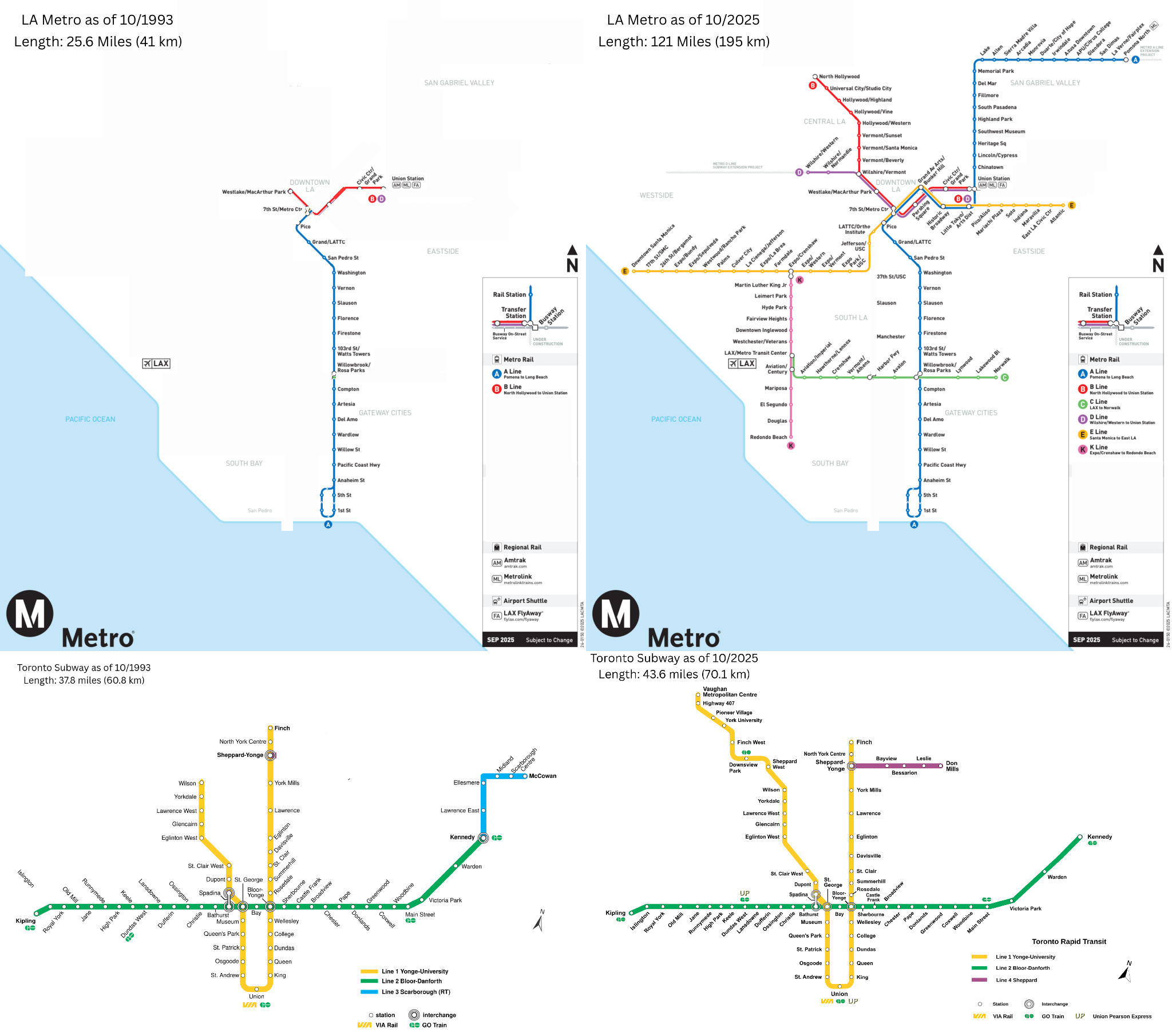Toronto vs. Los Angeles Rail Transit Networks Map


David Chen
Data Visualization Specialist
David Chen is an expert in transforming complex geographic datasets into compelling visual narratives. He combines his background in computer science ...
Geographic Analysis
What This Map Shows
The "World Series Transit Showoff: Toronto vs. Los Angeles Rail Transit Networks, 1993-2025" map provides a visual comparison of the rail transit systems in two major North American cities over three decades. It highlights the growth, expansion, and changes in the transit networks of Toronto and Los Angeles, marking significant milestones and developments in their respective rail infrastructures. This visualization not only reflects the evolution of public transportation in these cities but also sheds light on how urban planning and policy decisions have shaped commuting patterns.
Deep Dive into Rail Transit Networks
Rail transit systems are a crucial component of urban infrastructure, providing efficient transportation options that can alleviate traffic congestion, reduce carbon emissions, and enhance connectivity across metropolitan areas. In the context of Toronto and Los Angeles, these systems reflect the cities' unique challenges and approaches to urban mobility.
Toronto's rail system, primarily operated by the Toronto Transit Commission (TTC), has evolved significantly since the early 1990s. In 1993, the network consisted of four subway lines, with a total of 69 stations. Over the years, Toronto has made substantial investments in its transit system, including the introduction of the Sheppard Line in 2002, the extension of the Yonge-University line, and the ongoing construction of the Eglinton Crosstown LRT, set to be completed in 2025. The focus on expanding the network is indicative of the city's commitment to enhancing public transit and reducing reliance on personal vehicles.
What's interesting is that Toronto's rail transit is designed to integrate with other modes of transportation, such as buses and streetcars, creating a comprehensive network that serves a diverse urban population. As of 2023, the TTC carries over 500,000 riders daily, showcasing its importance in the daily lives of Torontonians.
On the other hand, Los Angeles presents a contrasting approach to rail transit. Historically known for its car-centric culture, LA has invested heavily in expanding its rail system in recent years. The Los Angeles County Metro Rail began operations in 1990 with the Blue Line, but significant growth occurred after the passage of Measure R in 2008, which allocated funding for transit projects. By 2025, the Metro Rail system will include multiple lines, including the Crenshaw/LAX Line and the Regional Connector, which aims to increase connections between existing lines.
Interestingly, LA's transit expansion reflects a shift in public perception regarding transportation. With increased awareness of climate change and urban sprawl, there has been a growing demand for reliable and efficient public transit options. The Metro Rail system has seen a rise in ridership, with over 400,000 daily boardings in recent years, indicating a positive trend towards public transportation use in a city long dominated by automobiles.
Regional Analysis
When analyzing the rail transit networks of Toronto and Los Angeles, notable regional differences emerge. Toronto's system is more compact, allowing for efficient travel within the densely populated downtown area and its surrounding neighborhoods. The city has focused on expanding its subway lines, which tend to be more reliable and less affected by traffic congestion compared to surface transit.
In contrast, Los Angeles is characterized by its sprawling nature, which presents unique challenges for rail transit. The city has had to develop extensive light rail and subway networks to connect its widely dispersed communities. This has led to a patchwork of transit options that require careful planning to ensure seamless transfers and efficient travel.
Moreover, while both cities are making strides in transit development, Toronto's investments have historically prioritized accessibility and integration, whereas Los Angeles has faced criticism for its reliance on freeway expansions. However, recent efforts in LA to improve public transport infrastructure signal a shift towards a more sustainable urban future.
Significance and Impact
The significance of comparing rail transit networks in Toronto and Los Angeles transcends mere statistics; it reflects broader trends in urban development, environmental policy, and social equity. As cities grapple with issues like traffic congestion, air pollution, and climate change, the importance of robust public transit systems becomes increasingly evident.
As we look toward 2025 and beyond, the implications of these developments will be profound. Cities that prioritize public transit not only improve mobility for their residents but also contribute to sustainable urban growth. The contrast between Toronto and Los Angeles serves as a case study on how different urban environments can shape transit policies and rider experience.
In conclusion, understanding the evolution of rail transit networks in these two cities reveals a lot about their past and future trajectories. The ongoing investment in transit infrastructure is not just about moving people but also about redefining urban landscapes for generations to come. As we navigate the complexities of modern urban living, these comparisons will continue to guide policy decisions and influence how cities develop their transportation systems for the future.
Visualization Details
- Published
- October 27, 2025
- Views
- 18
Comments
Loading comments...